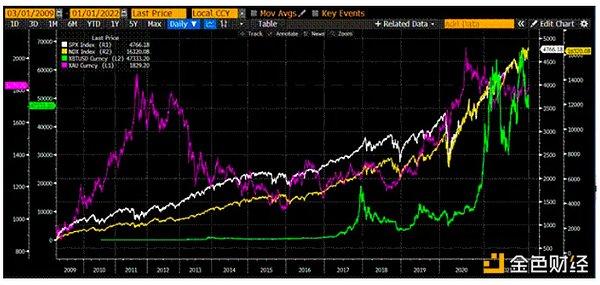Jinse Finance Reporter Jessy
On July 16, the stablecoin GHO of the decentralized lending protocol AAVE was officially launched on the Ethereum mainnet.
In the first one or two years after the birth of stablecoins, the industry will roughly divide stablecoins into three types: centralized stablecoins that are collateralized by real-world assets. The initial centralized stablecoins are only used as a tool for buying and selling other cryptocurrencies and preserving assets. In addition to stablecoins anchored to the US dollar, there are also stablecoins anchored to other real-world tokens or assets such as RMB. The second is a stablecoin that anchors assets on the chain, that is, a stablecoin that anchors mainstream cryptocurrencies such as Bitcoin and Ethereum.
And what is considered to be the pearl of the industry is the algorithmic stable currency. Algorithmic stablecoin is an algorithm-based cryptocurrency that mainly uses algorithms to maintain price stability, rather than relying entirely on the anchor of some kind of reserve asset.
However, after the Luna thunderstorm, UST, the algorithmic stablecoin that once ranked third, was directly zeroed, and this algorithmic stablecoin without external asset support was questioned. Currently, over-collateralization, multi-asset collateralization, and fusion algorithms seem to be a more reliable form of stablecoin development.
Shenyu said in an interview this year that stablecoins are still relatively early, and may only have completed 30 to 40 percent of the progress.
According to Golden Reporter, at present, centralized stablecoins still occupy the majority of the industry, but as the industry’s demand for anti-censorship becomes higher and higher, the industry’s demand for decentralized stablecoins will increase. The industry development path of decentralized stablecoins has also changed from paying more attention to algorithm stability to the combination of over-collateralization, multi-asset collateralization and algorithms.
AAVE is not the only lending protocol that releases native stablecoins, in addition to Maker Dao, Curve, Synthetix, etc. For Defi products, launching its own stable currency can enrich its ecology and resist centralized censorship. At present, the stablecoins launched by these protocols are basically a combination of over-collateralized and algorithmic stablecoins, and it is difficult for us to completely classify them as a certain type of stablecoins.
From Algorithmic Stability to Overcollateralization
Algorithmic stablecoins were once considered the jewel of the industry.
The most typical algorithmic stable currency is UST. Luna and the stablecoin UST are bound and born. UST can always be exchanged for Luna worth $1, while UST and Luna maintain a two-way burning and minting relationship. The arbitrage mechanism between UST and Luna keeps UST at $1. In terms of market value, UST once exceeded 18 billion US dollars, surpassing BUSD to become the third largest stable currency in the world.
This design is simple and ingenious, but there will be problems when the liquidity plummets. In May last year, a large number of UST was premeditatedly sold, the balance was broken, UST was depegged from the US dollar, and many people exchanged UST for Luna, which caused Luna to plummet. The price of the last two is almost zero.
The stable mechanism of the algorithmic stablecoin is designed in various ways, but many attempts have failed to effectively let the algorithmic stablecoin really get rid of the "death spiral": that is, when the price of the stablecoin is below $1, the stablecoin mechanism does not work and causes the price to fall further. Especially when liquidity plummets, the risk of de-anchoring will increase.
After the Luna incident, the industry began to reflect on algorithmic stablecoins. Since 2017, when the earliest algorithmic stablecoins BTC as Basis and Havven appeared, it should be considered from the core algorithm setting mechanism. One is to choose which tokens to bind in the selection of underlying assets, and the other is what mortgage (destruction) parameters can take into account both security and capital efficiency. In terms of lowering the mortgage rate to release collateral liquidity, GHO accepts various types of collateral in the AAVE protocol. Among them, the mortgage rate of AAVE is 400%, accounting for no more than 25% of the total storage. The facilitator (Facilitator) uses different types of mortgage assets for mortgage and unsecured issuance. The third is the demand for the use of stablecoins and who will mint them first, and how to regulate them. Taking GHO as an example, what it actually does is to achieve price anchoring by means of casting-market arbitrage.
The most important thing about stablecoins is security. How to avoid the death spiral should be the core proposition of algorithmic stablecoins. However, the problems that have not yet been solved in the traditional financial field are not so easy to avoid in the encryption field. At present, the industry is more inclined to combine mortgages and algorithms, and the mortgaged assets are generally mainstream encrypted assets, and some are real-world assets.
The specific logic of GHO
Taking GHO on AAVE as an example, we can see that it introduces the concept of mortgage, and it is mortgaged by multiple cryptocurrencies. Similar to GHO is the stablecoin Dai launched by Maker Dao, which is collateralized by a combination of multiple token systems such as ETH , USDC, BTC and other cryptocurrencies. The inspiration of GHO also comes from Dai in essence. The form of GHO operation is probably "deposit collateral → mint $GHO, burn $GHO → withdraw collateral".
GHO and Dai are also different. The assets mortgaged by GHO can still generate interest income, and there is a limit to the minting of GHO. GHO minting charges a certain interest rate, and all decisions are in the hands of AAVE Governance. Due to the E-Mode, stablecoin holders can also access GHO at a ratio close to 1:1.
In terms of specific practice, it borrows from the practice of frax finance to deploy an AMO system. Whitelisted entities can mint and burn GHO without trust.
In terms of specific mechanism design, holding and staking tokens AAVE can obtain stAAVE, which can reduce the total cost of minting GHO (that is, lower interest), which helps to reduce the pressure on AAVE 's secondary market sales and ensure the security of the AAVE protocol. All the interest expenses incurred by GHO loans will be sent to the DAO treasury. If GHO reaches the market value of DAI, estimated at an average interest rate of 3.5%, AaveDAO can earn nearly 150,000 US dollars per day, which is conducive to the price growth of AAVE , which will also make GHO more secure.
Among the stablecoins currently using over-collateralization, GHO, crvUSD, and dpxUSD are based on existing protocols. Through the over-collateralization model based on the existing liquidity, they can guarantee the stability of their prices to a greater extent. At the same time, some over-collateralized stablecoin projects have achieved a cold start through model innovation, such as HOPE, which uses the method of locking reserve assets and the creation of the DeFi ecosystem to maintain the price stability of stablecoins by establishing reserve pools and usage scenarios.
Features of GHO
In fact, the core logic of the stablecoin GHO issued by AAVE is consistent with that of Maker Dao, both of which are based on a certain mortgage rate and over-collateralized to mint stablecoins. The act of mortgaging and minting stablecoins is completely a market behavior.
However, the relatively innovative concept of AAVE is that he introduced a "central bank", which it calls a "promoter". According to the official statement, this promoter can be an agreement or an entity (elected). In fact, AAVE Dao should be playing the role of facilitator in the early stage. Facilitators can generate and burn GHO trustlessly. It is conceivable that the "central bank" will intervene when the stable currency is unanchored.
That is to say, in the issuance and destruction of GHO, there is both a very market-oriented side and a centralized side of "macro-control by the central bank".
For the "promoter", there is also a certain limit, which is called a "storage bucket", and the storage bucket specifies the upper limit of the GHO that a specific promoter can generate.
Specifically, GHO's borrowing rate and repayment cycle are determined through Dao governance. We can see from this that the issuance of GHO actually plays an important role in promoting the governance attributes of AAVE Dao.
It is very imaginative that using GHO in AAVE can realize a two-story nesting doll. Users take out their own virtual assets and exchange them for GHO, and then exchange GHO for other virtual assets. It can be exchanged for other stable coins without any slippage throughout the process.
But we should also see the other side of this design. Promoters in AAVE have the right to mint GHO without any collateral, which is too centralized. Once interested parties intervene, it may cause the risk of GHO de-anchoring. Even though AAVE has set up a storage bucket mechanism to limit the upper limit of GHO generated by promoters, both are elected by AAVE votes. If there is a collusion of interests, governance will turn around and become more and more centralized. In fact, Dao is still controlled by large investors at present, and ordinary retail investors actually have little say.
Finally, for the holders who obtain a large amount of AAVE at a very low cost, GHO is equivalent to a perpetual motion machine of interest. In the future, it is very likely that there will be a risk of thunderstorms caused by cashing out a large amount of AAVE with GHO in the market value of AAVE .
The entry of the lending agreement changes the way stablecoins are divided
For a protocol, issuing its own stable currency will actually increase the complexity of the protocol, and even become a vector of attacks. In recent years, due to attacks on stablecoins, it is not uncommon for protocols to go bankrupt, such as Cashio, Acala, and Bean.
Moreover, the competition for stablecoins is very fierce. Some decentralized stablecoins have built a huge moat in terms of on-chain liquidity and cooperation with other protocols. On this basis, it may be difficult for protocol stablecoins to obtain deep liquidity.
Will this be a thankless task for the agreement?
In fact, at present, it has become popular for lending agreements to launch their own stablecoins. This is well explained. Stablecoins are the place where the most money can be made. There is a huge demand and market here. More realistically, the stable currency issued by a super application with a specific user scale essentially bypasses the trust intermediary and directly forms a minting contract with its users. Protocols can use stablecoins as a way to increase the value accumulation and utility of governance tokens, and stablecoin issuers can establish direct deposit modules with other lending markets, or deposit collateral with AMM LPs (e.g., Maker's D3M and FRAX AMO).
GHO is an asset deposited by users into the AAVE protocol for over-collateralized casting. Therefore, the increase in demand for GHO will prompt more users to deposit assets in AAVE . In addition, stkAAVE holders who participate in security module pledges can obtain discounted interest rates to mint GHO, which encourages more users to participate in the pledge. At the same time, the rising demand for AAVE makes the price of AAVE more favorable, and the interest generated by GHO has also become a new source of income for the AAVE protocol. Therefore, for AAVE , the launch of GHO will directly enhance the competitiveness of the overall AAVE .
By comparing the native stablecoins launched by several lending protocols, we can see their respective characteristics. Maker Dao introduced RWA, which will eventually be an on-chain + off-chain mortgage asset model. What is interesting is that Maker DAO announced the Spark agreement in May, which aims to enhance the liquidity and revenue capacity of DAI stabilizing currency, that is, end users deployed on Ethereum, DAI -centered DEFI products, all have the supply and borrowing function of ETH, STETH, DAI, and SDAI, and all DEFI users can use SPI. The ARK protocol, and the focus of the protocol will fall in the free floating asset mortgage mortgaged on the reality of the real world assets.
CRV Finance launched crvUSD, which is interesting in its liquidation mechanism. Its Lending-Liquidation Automatic Market Maker Algorithm (LLAMMA) is a dynamic loan liquidation algorithm, that is, an automatic market maker is introduced into loan liquidation, so it is different from ordinary mortgage loan stablecoins. It is issued through over-collateralization, but uses a special-purpose AMM to replace the traditional loan and liquidation process. When the liquidation threshold is reached, the liquidation will not happen all at once, but will be transformed into a continuous liquidation/de-liquidation process. In this set of algorithms, the loss during liquidation will be reduced by dispersing the collateral in different price ranges. It generates arbitrage opportunities through a greater range of changes than the external price to dynamically liquidate the collateral. When the price falls, the collateral will become crvUSD, and it will return to the collateral when the price rises. The other two algorithms of the protocol, PegKeeper and Monetary Policy, are the mechanisms used by Curve Finance to anchor crvUSD at 1 USD. Although CRV Finance’s native stablecoin is still overcollateralized, it uses several algorithms to replace some traditional methods like liquidation and price anchoring, and it has more practice in the use of algorithms.
Comparing the stablecoins of several other Defi products, we can find that nowadays, each stablecoin has its own characteristics. With the development of the stablecoin track, we can no longer just classify stablecoins into the three types of stablecoins at the beginning. Today’s stablecoins are mortgages of online and offline assets, plus a combination of algorithms. Some people also proposed that the division of stablecoins can be divided into two types: "centralized stablecoins" and "decentralized stablecoins". But decentralized stablecoins also have a centralized side.
In addition to the role of asset value preservation, the stablecoin itself is the largest application scenario in Defi. Defi's various protocols have entered the stablecoin track, which has unique conditions, and the biggest beneficiary will also be the protocol itself.






